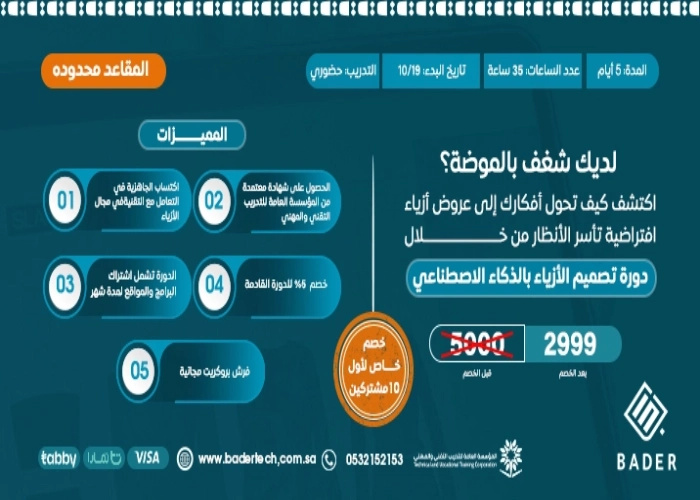Program Objective:
Developing and enhancing the trainee's ability to identify training needs using scientific methods.
Skills the Program Aims to Develop:
Enhancing the trainee's ability to identify training needs using scientific methods.
Objectives:
-
The concept and importance of training needs analysis.
-
Types of training needs analysis.
-
Analyzing the components of training needs.
-
Challenges in identifying training needs.
Outcomes:
Upon completing the training program, the trainee is expected to be able to:
-
Define the objectives of the training process.
-
Identify the types and methods of training needs analysis.
-
Design and prepare tools for training needs analysis.
-
Identify training needs for the workforce based on the organization's plans.
-
Prioritize training for employees within the organization.
-
Identify emerging training needs.
About course
Training needs analysis is one of the essential elements that directly contributes to improving employee performance within organizations. In today’s business world, it is no longer possible to rely on random or undirected training. Therefore, it has become crucial to carefully analyze training needs to ensure the maximum benefit from human resources.
Through this specialized course, you will learn how to analyze training needs using advanced methods and techniques, enabling you to identify the gaps between current skills and required skills in the workplace. We provide you with the right tools to develop an effective training plan that aligns with the organization's goals, leading to increased organizational efficiency and optimal performance.
The course will cover various topics including how to use training needs analysis techniques, data collection methods such as surveys and interviews, and how to identify individual and group training needs within teams. In the end, this training will equip you with the ability to apply best practices in training needs analysis to motivate and enhance employee performance effectively.
What is Training Needs Analysis?
Training needs analysis is a systematic process aimed at identifying the gaps between employees' current skills and knowledge and what is required to achieve the desired performance within the organization. This process is one of the core pillars in human resource management and organizational development, as it helps design effective training strategies that ensure improving employee efficiency and achieving the organization's strategic goals.
The training needs analysis process involves several steps, including data collection through surveys, individual interviews, and performance reviews. The main goal is to identify areas where employees lack skills or knowledge, which helps in targeting training programs accurately.
Training needs analysis is one of the most important tools used by companies to ensure improving employee performance and boosting productivity. Without precise identification of training needs, it becomes difficult to direct training resources toward the areas that most affect performance improvement.
Importance of Training Needs Analysis
Training needs analysis is one of the fundamental steps that directly contribute to organizational success. It allows companies and organizations to analyze the gaps between employees' current skills and the skills required to achieve the organization's strategic objectives. Through this process, training efforts can be directed accurately and effectively, helping improve performance and maintain employee efficiency.
Training needs analysis is the cornerstone that enhances employees’ capabilities and addresses skill gaps in the workplace. Without accurately identifying these needs, resources may be invested in training programs that do not meet actual business needs, leading to wasted time and money.
Importance of Training Needs Analysis in Improving Organizational Performance:
-
Achieving Sustainable Development: By precisely identifying training needs, an organization can design innovative training programs that align with its strategic goals, improving productivity and supporting long-term sustainable development.
-
Enhancing Employee Efficiency: Training needs analysis helps develop both individual and group skills, improving efficiency and reducing work errors. A well-trained employee is capable of delivering higher and more accurate performance.
-
Achieving Organizational Excellence: By investing in continuous training, organizations can better face market challenges and competition, leading to organizational excellence.
-
Supporting Business Strategies: Training needs analysis is a key step for enabling organizations to implement their development strategies and effectively invest in human capital.
How to Effectively Identify Training Needs:
Effective training needs analysis requires the use of multiple tools such as interviews, surveys, and performance analysis. Using these tools, organizations can assess how well current skills match required skills, allowing them to identify the appropriate training types to bridge these gaps.
Steps to Effectively Identify Training Needs
Training Needs Assessment (TNA) is a crucial step to ensure organizational performance improvement and employee skill development in alignment with the organization's goals. This process helps identify the gaps between current skills and the skills required, leading to the design of effective and tailored training programs.
-
Analyzing Current Performance
The process starts by evaluating the current performance of employees or various departments. This is done by reviewing performance reports, direct observations, and surveys to identify areas that need improvement. This analysis provides a baseline for understanding the current situation and identifying training needs.
-
Defining Training Objectives
Based on the previous analysis, training objectives are defined. These objectives should be aligned with the organization's strategic goals, such as improving productivity, enhancing efficiency, or developing leadership skills. These goals guide training efforts effectively.
-
Choosing Appropriate Data Collection Methods
The methods for data collection vary based on the type of training needs. Common methods include:
-
Individual and Group Interviews: To gather detailed information from employees and managers.
-
Surveys: To collect quantitative data from a large number of employees.
-
Document Review: Such as performance reports, action plans, and job descriptions.
-
Direct Observation: To monitor employees' actual performance during work.
-
Analyzing Data and Identifying Gaps
After collecting data, it is analyzed to identify the gaps between current skills and the required skills. This analysis helps pinpoint areas that need training interventions, such as communication, leadership, or the use of modern technology.
-
Setting Training Priorities
Given limited resources, it is crucial to set training priorities based on:
-
Skill Importance: How much it impacts job performance.
-
Degree of Gap: The size of the gap between current and required skills.
-
Time and Cost: The time and cost required to develop the skill.
-
Designing and Implementing Training Programs
Based on the established priorities, tailored training programs are designed to meet actual needs. These programs should incorporate various methods such as hands-on training, workshops, and e-learning courses to ensure effective learning.
-
Evaluating Training Effectiveness
After the training programs are implemented, their effectiveness should be evaluated through:
-
Comparing Pre- and Post-Training Performance: To assess improvement.
-
Surveys of Participants' Opinions: To gather feedback and evaluations.
-
Reviewing Work Results: Such as increased productivity or improved quality.
Bader Technology Center: Specialized Training in Training Needs Analysis
Bader Technology Center is one of the leading centers offering specialized training programs in training needs analysis. It relies on scientific and methodical approaches to analyze and evaluate needs, which contributes to developing employee skills and achieving organizational goals efficiently.
The Best Course for Training Needs Analysis
In today's business world, Training Needs Analysis (TNA) is a key step to ensure improving organizational performance and developing employee skills in alignment with the organization's goals. This process helps identify the gaps between current skills and knowledge and what is required to achieve the desired performance.
If you're looking to acquire effective training needs analysis skills, Bader Technology Center is the ideal choice.
Why Choose the Training Needs Analysis Course at Bader Technology Center?
-
Locally and Internationally Accredited Certificates
All courses at Bader Technology Center are accredited and recognized by official bodies, enhancing the credibility of the certificate and contributing to improving your resume and increasing employment opportunities.
-
Advanced Training Content
The training courses at Bader Technology Center offer advanced scientific and applied content that keeps up with the latest trends in the field of training needs analysis and helps participants acquire the necessary skills to effectively implement this process within their organizations.
-
Professional Trainers
Bader Technology Center’s team consists of highly experienced trainers in the fields of training needs analysis and human resource development, ensuring high-quality and impactful training.
-
Diverse Training Methods
Bader Technology Center offers a variety of training options, including in-person and remote training, to meet the different needs of trainees and ensure a flexible and comfortable learning experience.
-
Employment Opportunities
Completing the training courses at Bader Technology Center enhances employment opportunities as the accredited certificates from the center serve as a strong addition to your resume and open doors to exceptional job opportunities.
If you're looking to develop your skills in training needs analysis and obtain an accredited certificate to enhance your professional opportunities, Bader Technology Center is the perfect choice. Invest in developing your skills today and start your journey toward a brighter career future.


































